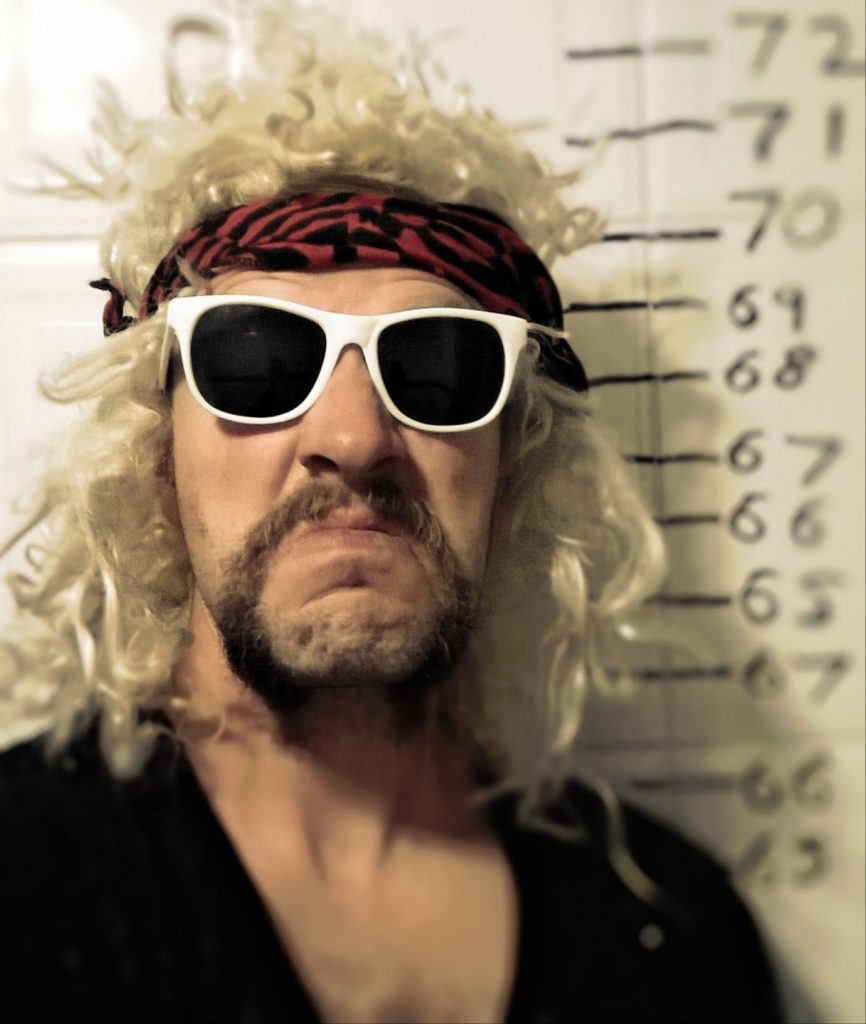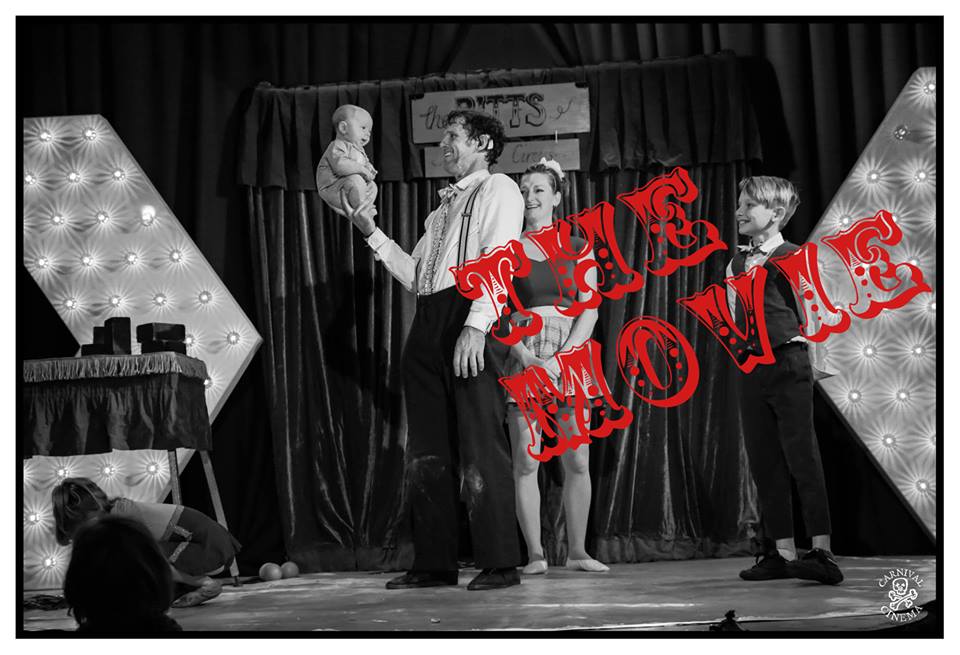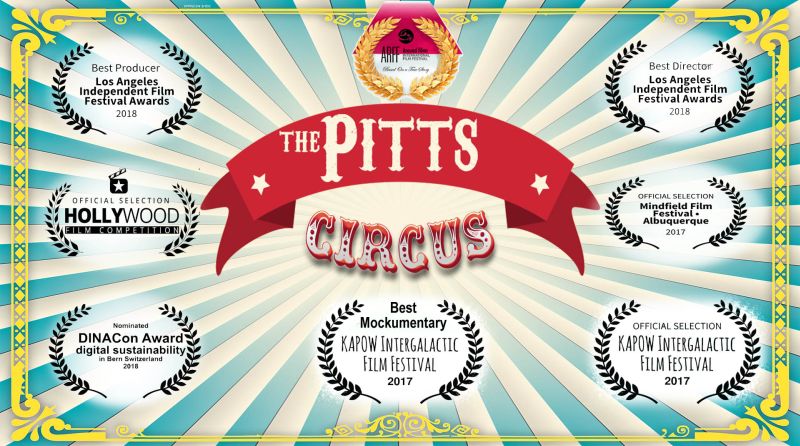A Madcap Journey of Clowns and Crypto-Currency–Making The Pitts Circus Movie
 At first glance, Ken Fanning is perhaps an unlikely film director for a mockumentary about an Australian circus family. Busy running his own big top circus show in Belfast called Tumble Circus, it would seem impractical for this self-professed anarchist clown to then pop over to Australia and make a film called The Pitts Circus, but Ken is anything but practical and his roots go straight back to street circus, where he has prevailed in large part due to his quirky sense of humor and what can only be the best street patter in the UK.
At first glance, Ken Fanning is perhaps an unlikely film director for a mockumentary about an Australian circus family. Busy running his own big top circus show in Belfast called Tumble Circus, it would seem impractical for this self-professed anarchist clown to then pop over to Australia and make a film called The Pitts Circus, but Ken is anything but practical and his roots go straight back to street circus, where he has prevailed in large part due to his quirky sense of humor and what can only be the best street patter in the UK.
So it is no surprise that this ability to sell oneself translates so well in the DIY world of independent film-making where Ken is excited to continue his work. What sets Ken apart from other DIY film makers is that he didn’t start with himself as a subject, and that he funded the whole award winning film with the help of his partner, using cryptocurrency. We had a word with Ken about his favorite project, and his answers were equal parts entertaining and eye-opening. For artists looking for a way to self-produce shows and films, Ken’s method might be a way to hone in on some emerging options.
What is this film all about?
The feature length film is about a real life circus family who are called the Pitts. The film was made on a micro budget and shot in 3 different countries with an international cast, and without a script. It is an Irish-Australian-Swiss Co-Production. We shot it in Western Australia, Ireland and Switzerland.
Can you tell us a little about yourself and your crew?
I’m the Irish director, Ken Fanning based out of Belfast. As well as making films, I run a non-traditional, internationally award-winning company called Tumble Circus. The producer of The Pitts Family Circus is Toni Caradonna. He is a cryptocurrency punk, art provocateur and a really nice guy.
 How did you get the idea to get this project underway?
How did you get the idea to get this project underway?
About a year and a half ago, I was at a circus festival in Australia and I was showing some of my short films. A Swiss man approached me, and told me how much he enjoyed my films and bought me a beer. I immediately thought, I like this guy. He asked me if I had any plans to make any more films, and I said I did. I actually didn’t have a next film project. The only real next project I had was figuring out how I could get this guy to buy me a second beer. I explained to him that I was just finishing the script for my next feature film. Which wasn’t really a lie, because for most of my life I have been making feature films in my head, and some of them I have even begun to write down. But in truth, I had never gotten to a stage in the writing process that could have been called ‘just finished’.
How did this project get launched? What was the trajectory? Most importantly, how was it funded?
Three months after our initial meeting, I started getting emails from Switzerland, a Facebook page appeared about the film, and then a website was launched for an Irish-Swiss film production company called “A Kenevil Thing.” Akenevilthing is the company that Toni set up to produced the film.
Real things were starting to happen, then one day Tony Skyped me form Switzerland. He had set up a meeting with a real Swiss film producer and a distributor, and said they would like to meet me next week and see the script. I didn’t have a script. And I can’t write– I’m dyslexic. So with the help of my girlfriend, we wrote a complete script about a cannibal eating circus family with a sweet-tooth for the clergy. Tony loved it.The producer and the distributor both loved it too. I am fairly sure they never read it.
Most people calculate avoiding the risk of serious injury, pain, or loss of life. Circus people calculate how much pain they can handle, how many injuries they can carry and how close to death they can navigate. And with this attitude we went foolhardy into making our film, knowing that if we did fail, no one would die.
A week later, I was in Bern, Switzerland sitting in a posh restaurant in the banking district, drinking overpriced beer. Tony, the producer and the distributor were crunching figures. They wanted to help us get the film made and had suggested that a budget of a quarter of a million should be enough. Tony was nodding his head in agreement, the producer was nodding his head, the distributor was nodding his head, I was trying to nod my head but was sipping beer and sort of spilt it over myself. I was thinking, ‘Quarter of a million? I can’t even pay my rent.’
The vibe was, they would give us half if we could raise the other half. Tony said no problem. I agreed and ordered drinks, and hoped someone else would pay for them. We didn’t raise our quarter of million. But money did arrive from a very special digital fairy–and that digital fairy was called cryptocurrency. 2017 was a great year to invest or create cryptocurrency. Both of which we did. Tony explained we were going to crowdfund our film though blockchain technology and cryptocurrency. We would be the first people in the world to do it. We would create our own crypto-token called EMV that would act as a token of value and a ticket to see our film and revolutionize the way film and art projects would be financed.
So you did it on a creative whim and pulled it off? Who was your backbone in the project?
Some have described Tony, my producer, as a bottomless well of positivity; or less generous folk might have said that he had more enthusiasm than senses. Tony decided we were making a film and told me we were going to Hollywood. This I believed was epic and utterly impossible, and because of those two reasons, I thought we should definitely do it.
 Where did you find the courage?
Where did you find the courage?
We were totally out of our depth. But because we are circus clowns, being out of our depth is what we do best. Falling flat on our faces and getting back up unharmed only to fall flat on our face again is our job. Circus teaches you not to be afraid and to take risks. Most people calculate avoiding the risk of serious injury, pain, or loss of life. Circus people calculate how much pain they can handle, how many injuries they can carry and how close to death they can navigate. And with this attitude we went foolhardy into making our film, knowing that if we did fail, no one would die.
What are you proud of about this work?
Together we made a movie, then we took it to Hollywood and we won awards. A lot of love went into it, and it was both exhilarating and exhausting. We won Best director and Producer at the Los Angeles Independent Film Festival, Best at the Mockumentuary Kapow Intergalactic Film Festival, and at the AFF Amsterdam film festival and Hollywood film Festival we were official selected.
We created a token called EMV which is a sort of share of the film and then launched it on crypto exchanges where it is traded. From its value we were able to fund our film. And yes, other artists could use the blockchain to fund projects. One day in the future our children will be taught about our digital revolutionary token in school.
What do circus clowns and cryptocurrency have in common?
They are both disruptive. Clowning is disruptive as it can challenge authority and it does so in often unique ways and often not on purpose. Cryptocurrency and the blockchain technology behind it is a disruptive innovation too. Tony told me that we were digital crypto punks, a vanguard of hackers, freethinkers, cyber geeks and anarchist clowns transforming the global finance and changing the world.
What was it like to be making the film? How did you get started?
In February 2017, we began shooting the film with second hand equipment we bought on Ebay. We had no script, but we did have 14 crew including; 3 kids, 1 chef, 2 retired acrobats, 1 French botanist, and a bunch of clowns–no one with any relevent filming experience. We were all camping in 38 degree heat, in a field, 6 hours away from the most isolated city in the world, Perth.
 On the first day of the shoot while Tony was showing off his drone flying technique, me and the chef spent 10 minutes trying to find the record button on one of the cameras. It was daunting. I reminded myself that I had made a bunch of circus shows, some of them had even been successful. Making films should be just like making circus. They say you can’t lie to yourself, but I found it very comforting and empowering. Films are a lot different than making circus shows. Film making is also much more of a collaboration. It’s a team of creative people pulled together to tell a story, and sometimes they have different ideas about how that story should be told and each person will have their expertise, be it in sound, camera or editing. All of these creative types will help shape the story of the film.
On the first day of the shoot while Tony was showing off his drone flying technique, me and the chef spent 10 minutes trying to find the record button on one of the cameras. It was daunting. I reminded myself that I had made a bunch of circus shows, some of them had even been successful. Making films should be just like making circus. They say you can’t lie to yourself, but I found it very comforting and empowering. Films are a lot different than making circus shows. Film making is also much more of a collaboration. It’s a team of creative people pulled together to tell a story, and sometimes they have different ideas about how that story should be told and each person will have their expertise, be it in sound, camera or editing. All of these creative types will help shape the story of the film.
What attracted you to this project? Was it the urge to prove someone wrong? To challenge yourself? To translate your clowning skills to a less ephemeral zone?
Half the charm of this project is that it’s not trying to be a Hollywood film. Many of my film-making friends said it would be impossible to make this film with all the limitations we had, but the resourcefulness needed to create circus came in handy when making the film. We managed to finish it in the cracks of our lives; in between family holidays, when it was our turn to do the dishes, or when we should have been asleep. We used new technologies, affordable high-end cameras and laptops to record and edit on; blockchain to fund and social media to market our project. We used all of this to make something we believed in, a film about a real circus family. We had an amazing adventure making it happen and it has opened all kinds of new doors for everyone involved. We had so much support and love from our amazing international circus community. They made this film happen.
How can people see the film or arrange for a screening?
If you want more information about our film or would like to buy a ticket please go to the website.
All photos courtesy of Ken Fanning & Akenevilthing
...
Do you have a story to share? Submit your news story, article or press release.





